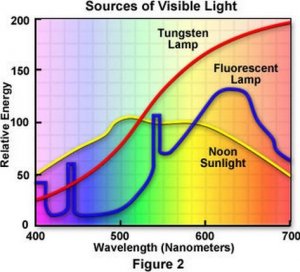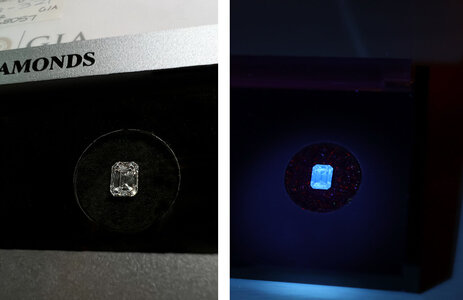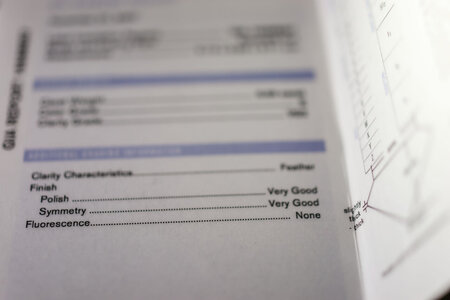- Joined
- Apr 22, 2004
- Messages
- 38,363
Garry, thanks for the link to the article. Indeed it is heavy going for the non-physicists in the crowd, myself being one! The particular relevance this article has for this thread, and which you alluded to, is the great variability in the wavelengths that the various UV light sources produce- even those used commonly in the trade and in the labs.Garry H (Cut Nut)|1437465071|3905546 said:What you are seeing is the effect of a totally different UV frequency or wavelength from your sources compared to what GIA and gemologists use.
Like so many things about our ancient and antiquated industry, we use tools that were available, not ones we should.
I have mentioned this before and some of the people who have replied seem to have overlooked what seems to be your an explanation too.
This article is heavy going for many, but if you just look at the charts on Figure 4. Note that the UV Loupe light emission of 403A is further to the right - infact it is at the edge of the violet visible range (395-450A).
http://www.gia.edu/gems-gemology/summer-2013-luo-fluorescence-optical-defects
This explains why your diamond is fluorescing with the readily available torch as opposed to the long wave used by labs.
So your stone is probably fluorescing nicely in all sorts of light and making the color less yellow.
Enjoy it
My horse is very much alive David. I look at diamonds every day and I read the science. But thank you for the kind advice just the same.Rockdiamond|1437601392|3906265 said:You're beating a very dead horse Bryan.
You are basing your argument on articles that don't even dispute the facts- instead of actually observing a simple to see physical characteristic.
Certain SB or MB stones in the D-L color rage look whiter than their body color in normal room lighting.
Please look at some actual diamonds so you can see for yourself.
Texas Leaguer|1437597140|3906224 said:Garry, thanks for the link to the article. Indeed it is heavy going for the non-physicists in the crowd, myself being one! The particular relevance this article has for this thread, and which you alluded to, is the great variability in the wavelengths that the various UV light sources produce- even those used commonly in the trade and in the labs.Garry H (Cut Nut)|1437465071|3905546 said:What you are seeing is the effect of a totally different UV frequency or wavelength from your sources compared to what GIA and gemologists use.
Like so many things about our ancient and antiquated industry, we use tools that were available, not ones we should.
I have mentioned this before and some of the people who have replied seem to have overlooked what seems to be your an explanation too.
This article is heavy going for many, but if you just look at the charts on Figure 4. Note that the UV Loupe light emission of 403A is further to the right - infact it is at the edge of the violet visible range (395-450A).
http://www.gia.edu/gems-gemology/summer-2013-luo-fluorescence-optical-defects
This explains why your diamond is fluorescing with the readily available torch as opposed to the long wave used by labs.
So your stone is probably fluorescing nicely in all sorts of light and making the color less yellow.
Enjoy it
For instance, this statement is made in explaining the difference between two of the UV light sources studied:
“Extra” emission from the conventional UV lamp at 405 nm causes the diamond’s blue fluorescence to be more intense than that from a “pure” 365 nm LED source. Such discrepancies contribute to problems with consistency and reproducibility of fluorescence observations within the industry.
Hi Bryan,
I only got half way thru your reply - and have a meeting - but google images of lighting specrta - wyou will see there is a lot of violet higher energy light from fluoro and LED's.
e.g. this one - and in our show room we easily see a benefit from uv even though the day-light has come through glass that will knock out the higher energy much shorter wave UV like the labs use.
If you consider the full range of UV light sources available out there for a whole variety of uses (such as nail drying in this case), there is no telling which wavelengths they are actually outputting. If a particular blue fluoro stone with a specific color center is stimulated at a particular wavelength and the UV source is low in that wavelength then fluoro will not be stimulated or will be stimulated very weakly. Conversely, if the source is for example putting out some visible violet (around 415 nm), the diamond may show some fluorescence where none would be present under a strictly contained UV source such as might be used in the lab. That could in fact account for this discrepancy between what we see in the photos and the GIA report.
As for the notion that the stone is "probably flourescing nicely in all sorts of light and making the color less yellow", I do not see anything in this study to support that. In fact, the modern science seems to be rather clear in terms of the intensities of UV and VV that are required to activate the fluorescent effect. Because UV intensity drops off so dramatically with distance from articicial light sources, normal indoor lighting environments (even overhead fluorescent tube lighting) are essentially UV free.
This particular article mentions that fact but does not specifically discuss it:
Observation of fluorescence can be affected by three main factors: (1) the nature of the emission from the UV light source; (2) the nature of the defect(s) responsible for the fluorescence; and (3) methodology, including the viewing geometry and the distance from the radiation source.
Other studies do demonstrate that diamonds must be observed within inches of indoor light containing a UV component in order to activate fluorescence and any color masking that might accompany it.

Hi Garry,Garry H (Cut Nut)|1437633388|3906390 said:Hi Bryan,
Busy day
Note the normal LED's actually have a fair bit of light way down in the shorter wavelengths too.


